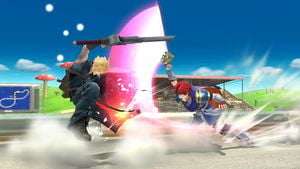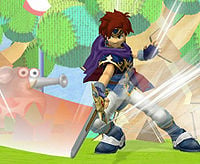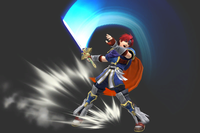Double-Edge Dance: Difference between revisions
m (→Customization) |
No edit summary |
||
| Line 33: | Line 33: | ||
# '''Double-Edge Dance''': Default. | # '''Double-Edge Dance''': Default. | ||
Like the other DLC characters, Roy lacks custom move variations. | Like the other DLC characters, Roy lacks custom move variations. | ||
==Gallery== | |||
<gallery> | |||
File:SSBUWebsiteChrom2.jpg|[[Chrom]] using the move in ''Ultimate''. | |||
</gallery> | |||
{{Multiple Special Moves|Roy|Chrom}} | {{Multiple Special Moves|Roy|Chrom}} | ||
Revision as of 14:30, November 12, 2018
| Double-Edge Dance | |
|---|---|
 Roy performing the move in Super Smash Bros. for Wii U. | |
| User | Roy Chrom |
| Universe | Fire Emblem |
Double-Edge Dance (マーベラスコンビネーション, Marvelous Combination), often abbreviated DED, is Roy and Chrom's side special move.
It is a variation of Marth's Dancing Blade (with which it shares its Japanese name), and has the same general behavior. However, the third hit inputted downwards and the last hit inputted in any direction deal a fire effect. Chrom's Double-Edge Dance doesn't have a fire effect, however.
In Super Smash Bros. Melee
This move is integral to Roy's metagame due to its range, speed, and KO potential. It is particularly effective for approaching, as the first hit can lead into a down tilt, grab, or the subsequent hits of the attack.
The first two hits of the four hit combo are relatively weak and easily crouch canceled by opponents, but they will come out no matter how quickly they are inputted. For the third and fourth hits, the player must wait a few frames between inputs or else the attacks will not come out. The tradeoff for the difficulty in inputting the later hits is significantly higher knockback, which can knock over opponents trying to crouch cancel.
The third hit of the combination inputted upwards has a meteor smash hitbox, producing a slightly diagonal trajectory if the sourspot doesn't hit. On grounded opponents, it will knock them into the air and set up for the fourth hit. Inputted forwards, the third hit deals excellent knockback and can be used as a KO move at higher percentages. The third hit inputted downwards produces a flame effect and can knock over opponents trying to crouch cancel. Unusually, while the third hit forwards has higher base knockback, its growth is actually smaller than Dancing Blade's version, meaning it is overall less powerful at higher percentages, while also being harder to link the fourth hit together with the third hit at lower percentages.
With the exception of the downwards input, the final hits of DED deal the most knockback compared to the other hits. The upwards input has high vertical range and high knockback. The down input actually deals multiple hits, and while it deals little knockback, its long range and duration make it effective for shield stabbing and knocking down opponents attempting to crouch cancel. Compared to the other inputs, the forward one is lackluster, and rarely used.
In Super Smash Bros. 4
Roy again uses the Double Edge Dance in SSB4, where it has been updated to use Marth's Dancing Blade animations from Brawl and SSB4, making it one of Roy's only attacks that has not gained an animation distinct from Marth. Its many attacks have gained different attributes when compared to Melee, making its first few hits act similar to Dancing Blade, although the third and final hits have been slightly changed.
As with Dancing Blade in Brawl and Smash 4, the first hit stalls Roy's movement in the air for a few frames, although this benefits Roy's recovery much less when compared to Marth as he has a higher falling speed. All hits of the attack now require less technical precision to input in a row, making the attack easier to combo, although the general nerf of Marth and his counterpart's Dancing Blade variants chaining together less reliably affects him as well. Despite this, Roy's sweetspot at his sword's hilt allows him to rack up damage much easier than Marth or Lucina by starting the move close to an opponent. However, the first hit has 2 more startup frames, and each hit deals less knockback and damage than in Melee, although each individual hit has less startup.
The third hit of the move no longer deals flame damage or does exceptional knockback; this has been moved to the fourth hit and the third hit makes combos into the fourth hit much easier compared to Melee. Because of the new knockback placements for each attack, Double-Edge Dance is a much more reliable finishing move and combo tool in general compared to Melee due to the third hit's lower knockback, and its damage-racking and shield-pressuring potential still makes it an integral part of Roy's moveset.
Customization
Special Move customization was added in Super Smash Bros. 4. These are the variations:
| 1. Double-Edge Dance |
|---|
| "Time your attacks to unleash a four-hit chain. Pressing up or down will change the attack." |
- Double-Edge Dance: Default.
Like the other DLC characters, Roy lacks custom move variations.
Gallery
Chrom using the move in Ultimate.


